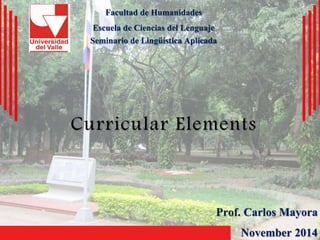
Syllabus desing
- 1. Facultad de Humanidades Escuela de Ciencias del Lenguaje Seminario de Lingüística Aplicada Curricular Elements Prof. Carlos Mayora November 2014
- 2. Warm-up Beyond the design of methods, the design of instruction is a typical activity of applied linguistics. In this class, we will look at some of the tasks of course design and specially at curricular elements.
- 3. Course design defined Process Designing/creating Instructional system Development of L2 knowledge and skills
- 4. Extending the definition Process Systematic Steps/phases/ stages Goal-oriented Developmental
- 5. Extending the definition Goal(s) Learners Instructional System Instructional materials Procedures Activities Teacher(s) Assessment
- 6. Grammar Vocabulary Pronunciation L2 Knowledge/ skills Speaking Reading Writing Listening General interest Special purpose Extending the definition
- 7. Extending the definition In that definition, we see that the process is a. systematic; b. practical; and c. it tackles a real-world language related problem. We could also add that the foundations of the process are interdisciplinary in nature since it deals with both the nature of language, the nature of learning and it needs to address a number of resources. Thus, it is applied linguistics in action.
- 8. • Curriculum and materials design. • Resources available, both material and human. • The linguistic system • Mental processes involved in learning Psychology Linguistics L2 curriculum design Management Education Interdisciplinarity
- 9. Central elements Approach Syllabus Techniques Exercises Brown’s categories (1995)
- 10. Central elements Theory/beliefs about language Theory/beliefs about learning Instructional material Approach Syllabus Techniques Exercises Selection and grading of content Teaching Assessment
- 11. Curriculum CURRICULA are concerned with making general statements about language learning, learning purpose and experience, evaluation and the relationships between teachers and learners… [ they also include] banks of learning items and suggestions about how these might be used in class Nunan, 1988, p. 3 CURRICULUMis a very general concept which involves considerations of the whole complex of philosophical, social and administrative factors which contribute to the planning of an educational programme. Allen, 1984, p. 6
- 12. Syllabus provides direction and guidance in the scope, sequence and pacing of classroom activities. Omaggio, 1986, p. 410 Syllabus Syllabus is …an inventory of objectives the learner should master… in a recommended sequence. Celce-Murcia, 2001, p. 9
- 13. Stages in educational planning National ministeries/offices Regional administrative unit The department The classroom Curriculum Syllabus Lesson The Institution
- 14. Types of Syllabi
- 15. Types of Syllabi A type or kind of syllabus is defined by… • its focus (grammar, meaning, lexis, etc.); • its units of progression; and • its grading criteria,
- 16. Grammar, formal language structures Communication Specific language skills (i.e. listening) Difficulty or complexity (intuition) Discrete structural items (i.e. rules, tenses, sounds) Situations (i.e. at the airport) Notions (i.e. time, quantity) Usefulness for student or chronology. Usefulness (based on intuitions) Topics or themes (i.e. The government) Usefulness or chronology. Interest Social functions of language (apologizing) Frequency, usefulness or chronology Hierarchy (sub skill A is necessary for sub-skill B) Sub-skills or micro skills (i.e. listening for the gist) Usefulness or frequency or hierarchy. Tasks, either pedagogical or metacommunicative. Tasks or cognitive processes Learners’ interests or needs (negotiation) Types of Syllabi
- 17. Three perspectives on selecting and grading content 1. Identify the general contexts and situations in which the learners will communicate. 2. Specify the communicative events the learners will engage in. 3. Make a list of the functional goals that the learner will need in order to take part in the communicative events. 4. List the key linguistic elements needed to achieve functional goals. 5. Sequence and integrate 3 and 4. Nunan, 2001, p. 63
- 18. 1. contexts and situations 2. communicative events 3. functional goals 4. linguistic elements 5 First perspective: CLT
- 19. CLT perspective
- 20. Second perspective: Task based Long and Crookes, 1992
- 21. Second perspective: Task based
- 23. Second perspective: Task based
- 24. Third perspective: Multi-layered perspective • The units of progression may vary from course to course. • Whatever unit of progression chosen, course designers need to check other units are also covered and dealt with within the appropriate level for the student. Nation and Macalister, 2010
- 25. Nation and Macalister, 2010, p. 73 Multi-layered perspective
- 26. Multi-layered perspective: Suggested grading criteria Language areas Research based suggested criteria Vocabulary West’s General Sevice List, Coxhead’s Academic list Grammar Georges’ Verb form frequency counts Functions Van Ek notional syllabus Council of Europe’s list of functions
- 27. Multi-layered perspective: Suggested grading criteria Language areas Research based suggested criteria Discourse Biber’s work on co-occurrence Swales textual genre categories* Skills/sub-skills Skill taxonomies (Brown’s or Richards’). Cognitive taxonomies (Bloom) or strategy inventories (Oxford) Ideas Ideas relevant to the course for their value to motivate learners, familiarity and encouragement of language use.
- 28. Multi-layered perspective: The matrix
- 29. Bibliography and suggested readings • Brown, J.D. (1995). The Elements of Language Curriculum: A Systematic Approach to Program Development. Heinle & Heinle Publishers. • Celce-Murcia, M. (2001). Language teaching approaches: An overview. In Celce-Murcia, M. (Ed.) Teaching English as a second or foreign language (3rd ed., pp. 3-11). Boston, MA: Heinle & Heinle. • Long, M. & Crookes, G. (1992). Three Approaches to Task-Based Syllabus Design. TESOL Quarterly, Vol. 26, No. 1. pp. 27-56. • Nation, I.S.P. and Macalister, J. (2010). Language Curriculum Design. New York: Routledge. • Nunan, D. (1988). Syllabus design. Oxford: Oxford University Press. • Nunan, D. (2001). Syllabus design. En M. Celce-Murcia (Ed.), Teaching English as a second or foreign language (3º ed., pp. 55-65). Boston, MA: Heinle & Heinle. • Omaggio, A.C. (1986). Teaching language in context. Proficiency oriented instyruction. Boston: Heinle & Heinle Publishers, Inc. • Richards, J.C. (1990). The language teaching matrix. Cambridge: Cambridge University Press.
